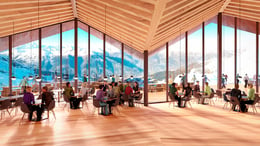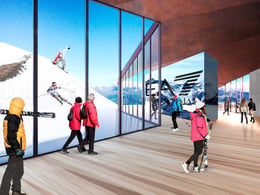Login
Registered users

An edelweiss is about to bloom on Platta de Grevon. The Pila ski area in Italy’s Valle d’Aosta will soon have a new cable car designed by DeCarloGualla, an architecture practice headed by Jacopo De Carlo and Andrea Gualla. With a capacity of 2,400 people per hour and a speed of six meters per second, the lift will carry skiers a distance of 2.4 miles (3.8 km) and up 3028 feet (923 m) from the bottom to the top stations in about a quarter of an hour. This means that skiers will be able to spend an average of thirty percent more time on the slopes every day.
The tender for the project specified the modernization of two existing lift systems, both built in the ’80s: the Pila-Gorraz and Couis-Drink chairlifts. Comprising two sections, the new cable car system will link the center of Pila, at an altitude of 5905 feet (1800 m), with Platta del Grevon, at 8933 feet (2723 m). The top station, designed to resemble a cross between an edelweiss and a wind rose, will occupy a mid-point between the Pila and Cogne Basins, with views of all the highest and most beautiful surrounding peaks.
DeCarloGualla approached the competition to design the bottom and top stations knowing that they were going to have to deal with two utterly different natural settings, and that they would need to weave the architecture into these striking and unique landscapes.

The bottom station, designed by DeCarloGualla, will be built adjacent to the top station of the existing Aosta-Pila system, in so doing creating a new hub in the center of the town, which, established in the ’70s, doesn’t have the traditional layout of a mountain village. Originally, Pila was summer pasture for livestock, with a scattering of huts and shelters for animals and herders. Building this interchange between the ski lift from Aosta and the new lift to the top of Couis is therefore an opportunity to create a new center of gravity for the village.
The bottom station has been designed to manage substantial people flows, in particular, arrivals from Aosta and departures to Couis. For this reason, a long, highly distinctive covered walkway has been designed between the existing and new structures. For people arriving by car or staying in the village, another covered walkway will lead to the cash desks, a locker room, and an information point, and then on and up to the cars themselves via stairs, an elevator, or a ramp.
“The ski lifts all converge on a kind of undercover square,” explain Jacopo De Carlo and Andrea Gualla. “The two ski schools and the information point are on the upper level and look down into this space. Lightness, transparency, dynamic representations of people flows, an openness to the drama of the surrounding landscape, and constructive simplicity are the concepts that we tried to capture in our design of the bottom station.”

The top station is the hallmark of DeCarloGualla’s design, its shape reminiscent of an edelweiss merged with a wind rose. The station is located in one of the most spectacular parts of the entire Valle d’Aosta region, with views of Gran Paradiso, the Mont Blanc chain, the Rutor Glacier, and Grand Combin. At the point where the lift arrives on Platta de Grevon, Pila is on one side and Cogne is on the other. Inside the station, however, there’s a panoramic restaurant with large windows that overlook all the surrounding peaks.
“We thought of an edelweiss,” say the architects, “which, like all natural organisms, changes its symmetrical shape when it can’t grow in a certain direction. So, we merged the image of an edelweiss with that of a wind rose, with each petal pointing in a particular direction. The first petal, the largest, houses the station itself and overlooks Pila; the last is oriented towards Cogne. The five petals of the bar and restaurant offer views of the highest, most spectacular peaks in Valle d’Aosta: from the south, they’re Gran Paradiso, Grande Rousse, the Rutor Glacier, Mont Blanc, and Grand Combin. Another petal, distinguished by its different height, thrusts out into the open air to the north. This is a breathtaking lookout point and, from its tip, the panorama is complete, with views reaching as far as the Matterhorn.”

One of the main goals of the new Pila-Couis cable car is to make this area increasingly attractive to tourists in both summer and winter. The resort wants to increasingly embrace the concept of accessible tourism, which, in the mountains, has important repercussions on the social fabric as well as on boosting the area’s competitiveness as a tourist destination in general. The facility will therefore also make it possible to enjoy the locale as a place for total relaxation, without detracting in any way from the experience of people who come here for the skiing, cycling, and hiking. At the mountain top, people will find a refuge offering every comfort. Comfort for the future, starting today.
“Architecture takes many forms but it is always anticipating the future. Indeed, the architects and engineers of today are currently planning the built environment of tomorrow. As such, it is their job to try and predict what the future inhabitants of this environment will expect, desire, and require” – the opening words of the editorial by engineer and architect Werner Sobek for The Plan 133, a long read about the value of designing “possible utopias.”













Location: Pila, Aosta
Architects: DeCarloGualla
Date: in progress
Render by DeCarloGualla studio di architettura, courtesy of the authors